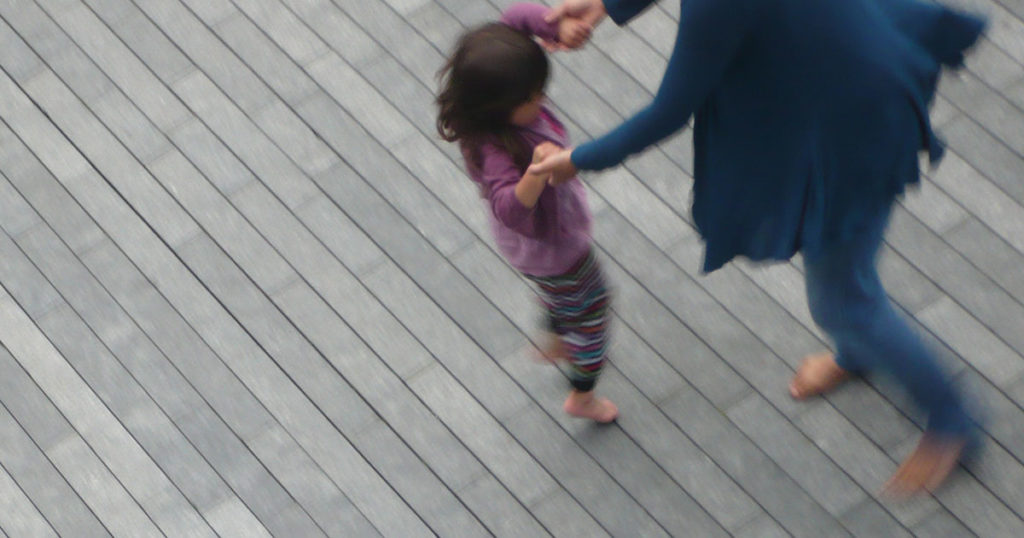
Children, especially if they are in thrall to the music, can easily tread on your toes when dancing with you. To keep that from happening, have the child stand directly on your feet, facing you, and you’ll see that by holding her hands, you can guide her around the room mounted on your feet. You don’t trip over her; she doesn’t step on you. Win-win, and fun too.
Initially surprised at having her feet pushed up from the bottom, the child will quickly learn to anticipate the lift of your feet and raise hers in perfect synchrony, so that the two of you appear to be, even more than a team, one smoothly functioning unit. But how does it feel to the two halves making up the whole? The child, held, manipulated, maneuvered, is pleased because her foot is on top, making her seem to be in power. On her face is first concentration, then giddy delight. She throws her head back, laughing. At the height of the arch, the child pushes down in anticipation of the adult’s movement, as if her downward pressure drives the adult’s foot to the floor. Does it seem to the child that she is pedaling the grown up? A tug on this arm, then a tug on that can add to the illusion that she is in control, steering where she wants. She thinks she’s got the upper hand because she’s got the upper foot. She’s very happy.
For you, the adult, the challenge is keeping the enthralled dancer from throwing all her weight back, pulling on your arms, testing your spine and shoulders, tiring you out, upsetting your balance, and even dragging you to the floor. But if you manage, there is the satisfying weight of success, like a blanket on your shoulders, as around the room you two go, bound together in your endeavor, you in control and the child thinking she is.
The threat of having your toes stepped on by other beings isn’t so pleasantly handled. And to be trod on can be quite painful. A horse will bruise, break, or even crush your toes, and slighter animals can cause pain too, especially if they are at a run and you are barefoot. Hop around though you might if stepped on by your pet, clutching your foot or howling, you don’t however take it personally, no more than you would with the child, and the pain subsides. But with your problematic workmate, or your boss, or your employee, or sister, brother, son, mother, or your ex, the stepping on is figurative, but the pain is nevertheless real. More real than real. You’re not harmed, but you are hurt, even when the stepping is unintended, because couldn’t that person have paid better attention and been less careless? If, even worse, done knowingly, then the blatant disregard for you is an aggression. Your pride is affected. Still, nothing is physically broken, and anyone can live with being walked over from time to time.
But some people have to put up with a lifetime of it. “Una santa,” a saint, people in Spain will say of some long-suffering, trod-upon woman. It’s husbands and sons, sometimes fathers, often boyfriends whose doltish or churlish behavior is the offense through which the woman demonstrates her excellence by putting up with it. A saint in the old paintings often appears glorious in robes of blue or crimson, but I picture this kind of domestic santa in a black skirt and shapeless black sweater and shawl, staring at you with dark eyes. Her face is long, her skin roughened from exposure to sun and wind, her hands red from work, maybe someone from the dry hills of the mountainous regions of Castilla y León, living in a hovel and surviving on a small hard patch of land. I’ve seen photographs of such women—and not just women but also men and children, all looking ground down, worn out, barely surviving. This was the look of the campesinos, country people, that I saw some years ago in a photo exposition in the León village of Riolago. Were the photos from the 1930s, I had wondered, or the ’40s? They’d vaguely recalled to me images of sharecroppers in the South during the depression. I leaned closer to read the date on the card beside a photo, then blinked for a second look because the year, 1982, had to be wrong, it was so recent.
But all the cards gave similar years, in the ’70s and ’80s, though the subjects, photographed standing in the doorways of their soot-blackened kitchens or beside their collapsing stables amidst a clutter of old milk cans and broken farm utensils, appeared to be staring out from half a century earlier. In their eyes was not fierce pride at surviving harsh conditions but a tiredness that resists compassion. “You don’t know me” was in their gaze. You don’t know me. Remembering the photographs, I almost hear a woman saying this from beside her cook stove, and I imagine her turning her back on me. She had work to do, she had no time for the role of a santa—of making a show of virtuous forbearance in the face of life’s cruelties. Whatever aggression she suffered from the grim-mouthed man lurking behind her was to be borne because it had to be, like the cold of the mountain winters and the scorching dry summer heat. Like the weather, it was beyond her control. Perhaps beyond his because what can you expect but cruelty from someone who’s been cruelly treated? For these two, shackled together by hardship, there was no dancing. No gentle twisting and pulling, resisting and giving. No flushed fumbling. No dance to protect egos while limiting damage. Their only dance would be the merry dance life led them. How did that feel for those two cogs meshing in the rumbling machinery?

